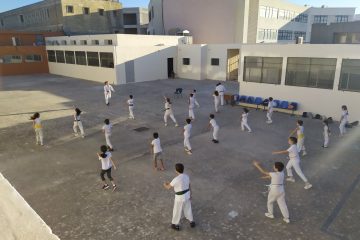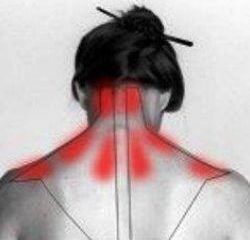One of the first things anyone will notice when training karate is the custom of bowing, called the “REI”. The custom of bowing in karate is traced back to its origins, which includes both the fact that it originates in Japan and due to it being a martial art which has foundations in budo.
The Japanese word for “rei” 礼 literally means “an expression of gratitude” but its use in martial arts has deeper levels of meaning.
Bowing is an integral part of Japanese culture which relies heavily on showing respect in the appropriate situations. The importance of this can be seen in that there are multiple ways of bowing and they mean or transmit different things to the person on the receiving end of the bow.

- Greeting Bow, Eshaku (会釈), 15 Degrees: This bow is for greetings, mostly for people you already know or are equals with, but not on a friendly-enough level to just nod to.
- Respect Bow, Keirei (敬礼), 30 degrees: This is where bowing gets respectful. Thirty degrees is actually quite a lot and feels like quite a lot, if you go ahead and do it. This bow is reserved for your superiors / other people who are higher ranking than you. You could probably do a little more than 30 degrees if you wanted to, too.
- Highest Respect Bow, Saikeirei 最敬礼, 45 degrees: This is the bow which shows the most amount of respect (or regret) possible.
- Kneeling Bow, Touch Your Head To The Floor: A bow modernly used only in martial arts to show a great deal of respect or regret.
The Japanese use the bow to as “a term of respect, remorse, gratitude and greeting.”
The Bow or Rei in karate has similar connotations to those associated to it by the Japanese culture.
| 礼 | れい | rei | thanking; expression of gratitude |
| 敬礼 | けいれい | keirei | salute; bow |
| 最敬礼 | さいけいれい | saikeirei | a respectful bow |
| 一礼 | いちれい | ichirei | bow (salute, greeting) |
| 立礼 | りつれい | ritsurei | bowing while standing; standing bow |
As can be seen from the definitions of the characters above, especially the first one which appears as a component of each of the others following it, a “rei” is an expression of gratitude. This aspect of the rei is also important in karate. Whenever you perform a “rei” you are showing your gratitude at being given the opportunity to train. Be it when entering the dojo, or a rei towards your training partner or your sensei, the “rei” should always be associated with a show of gratitude. Gratitude for what? Gratitude for being given the opportunity to train with your partner as well as gratitude towards the sensei for taking the time to teach us the way of karate and for being always there for all the karateka to show them how to train and improve. Gratitude is also expressed towards all those who work or have worked hard in order to uphold and pass on the discipline of karate throughout the years.
The above is what is garnered from the meaning of the word, but the “rei” in karate is much deeper than that.
According to Sensei Hirokazu Kanazawa, “the term [rei] refers to the act of two people facing each other and bowing in a display of mutual trust and respect.” However, the rei also “serves as a means of initially displaying respect for a person’s character, contributes to well-balanced relationships between people, and provides a way for preserving social order.” So the “rei” in karate is also a means of showing respect. And through the respect you show in your karate “rei”, karate also teaches you to become a better person even in one’s daily life. The meaning behind the “rei” is therefore also connected to the Dojo-kun (see other article) and is an intrinsic part of what Karate is all about.
As Gichin Funakoshi states in his Twenty Guiding Principles of Karate: “Karate begins with rei and ends with rei”. Without the rei and it’s underlying philosophy, there is no karate. Gichin Funakoshi’s phrase, however, cannot be loosely interpreted as merely meaning that you rei before you start training/practicing karate and at the end as is often pictured and badly publicized in movies. The phrase “Karate begins with rei and ends with rei” means that there must be respect and good manners in all the karate that you do for it to be real karate. Respect when facing an opponent as well as respect for those training with you and for your surroundings, including respect for the technique, skills and values being passed on to the karateka. Karate teaches you to respect everything. Therefore there is no karate without respect and this respect should be reflected in all aspects of a karateka’s life. The phrase also implies not only that there be respect at the beginning and the end, but respect throughout and since it begins and ends with “rei”, one can even say that it is a circle since begins, continues and ends with the same guiding principle that remains constant and present throughout. Like a circle has no beginning and no end as well as being the same throughout as it forms a continuous line, so must there be “rei” in a karateka’s every action. As Hirokazu Kanazawa says: “Everyone who learns karate-do must gain a deep understanding of rei, and must always adhere to the tenets of proper reigi.”
When to rei in Karate:
In Karate training, the first rei is done when entering the dojo or training hall. This is done as a sign of respect for the place where karate learning is fostered and in which you will be learning karate yourself. It is also done as a sign of respect to the other karateka who are already inside and will be training with you. This bow is done both when entering and when leaving the dojo as a sign of respect for the learning and training that takes place inside. But the respect shown to the dojo must not end with the bow. It is expected that you as a karateka show respect to the dojo not only by bowing but through your other actions as well. Ensuring that the dojo is kept clean (like ensuring you do not leave multiple footprints as you enter and leave or leaving items behind) and that you do not shout or make excessive noise inside is another way of reinforcing what is meant by the bow you execute upon entering and leaving. Bowing upon entering and leaving the dojo should be done with meaning, keeping in mind your respect towards the dojo as a physical location and the people who train within it. Respecting the dojo does not end with the bow.
It is also good etiquette to bow to the sensei when they enter the dojo. The bow being a sign of respect, it is only natural to bow to the instructor who dedicates their time and effort in teaching with such dedication as they pass on their karate knowledge and experience on to you. The bow also shows respect to the sensei’s commitment throughout the years, not only in their teaching of karate but also in their achievements and pursuit of the true martial art, without which you would not have the opportunity to learn and practise karate.
In karate, we also bow at the beginning and at the end of the session. The rei or bow is often also accompanied by a resounding “osu”. The rei at the beginning of the session is carried out as a sign of respect and appreciation to the instructor who will be teaching, to the dojo, to the other karateka and to the values and principles represented by karate. Even during the training session itself, when facing a partner, you rei to show respect to the other person. You are showing them respect as your training partner and bowing also as a sign of gratitude for being given the opportunity to train with them during the session. The rei is used both before pairing up with someone and when the exercise is over.
The rei should be imbued with feelings that represent respect towards the karateka, the training they have pursued and the level they have achieved and are willing to share their training experience with you by practising karate together. That being said, it is only natural that as a karateka, you live up to that rei by giving your all during the training assigned to you. Doing techniques half-heartedly goes against the very principle of respect expressed by the rei in the first place. Respecting your training partner by paying attention and executing the exercise to the best of your abilities is also a part of the respect behind the rei. Remember that when you rei to your partner, you are thanking them for the opportunity to train with them and are therefore expected to give your utmost and live up to the gratitude you expressed with your rei.
Therefore the meanings associated to the rei are not limited to the karateka knowing what the rei represents, but must also be expressed in all things that a karateka does, both when training and outside. It would be very hypocritical to rei to someone of higher rank and then address them inappropriately.
Gratitude and respect in the rei are also present in the final rei at the end of the session. After the final rei to the sensei in the session, it is oftentimes observed that karateka in line turn towards the higher ranks and rei towards them too as a sign of respect for the training shared as a fellow karateka.
Arriving late to a training session should not be done since it is disrespectful to arrive late to the dojo. Usually, if a karateka arrives late for the session, they are expected to wait kneeling by the entrance and wait for the sensei to grant them permission to enter. In this case, a more formal version of the rei where one touches their head to the ground is expected before entering the dojo. This is done as a sign of deep regret for arriving late to the training session and disturbing the smooth flow of the session by your late arrival.
One can also say that the bow is simply a mere physical representation of the respect that should be present in a karateka’s life and that it should serve as a constant reminder of the true spirit of Karate which should be the ultimate pursuit of every karateka.
Article was written for S.K.A. by Ms Michelle Salem Rizzo, 2nd Dan Shotokan Karate – JKA, Master of Arts (M.A.), P.G.C.E., Bachelor of Arts (Hons).


